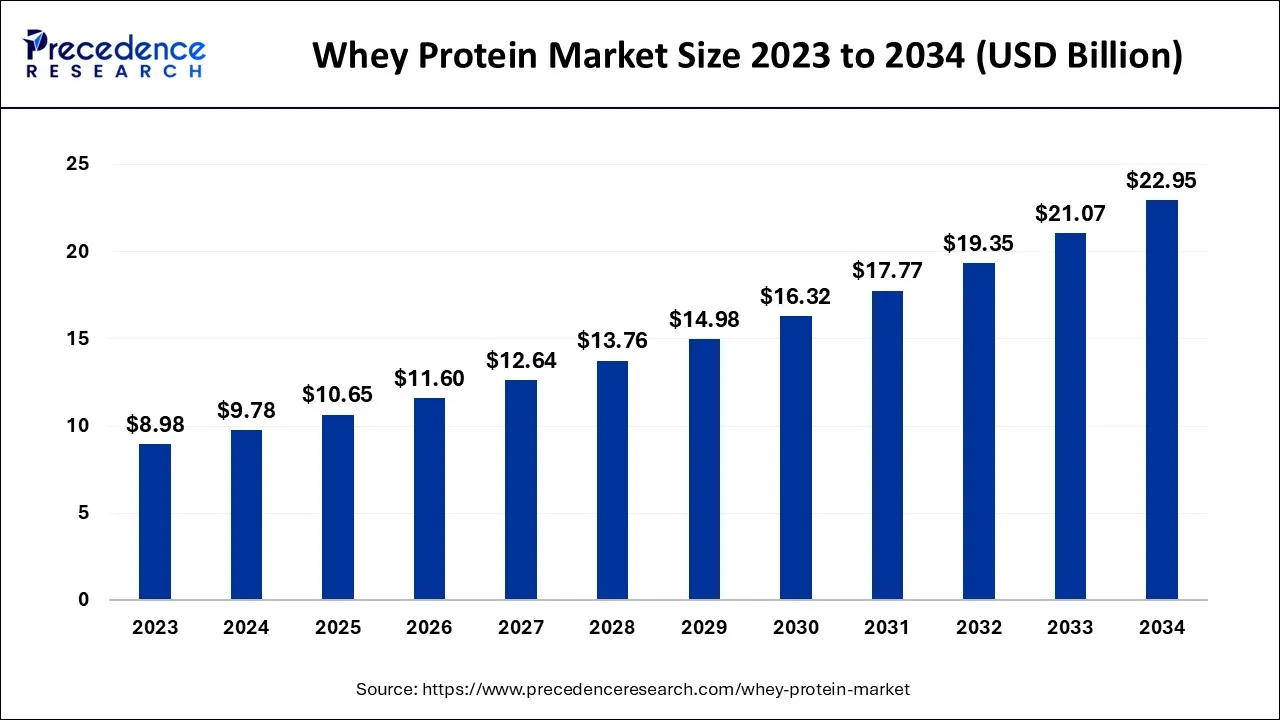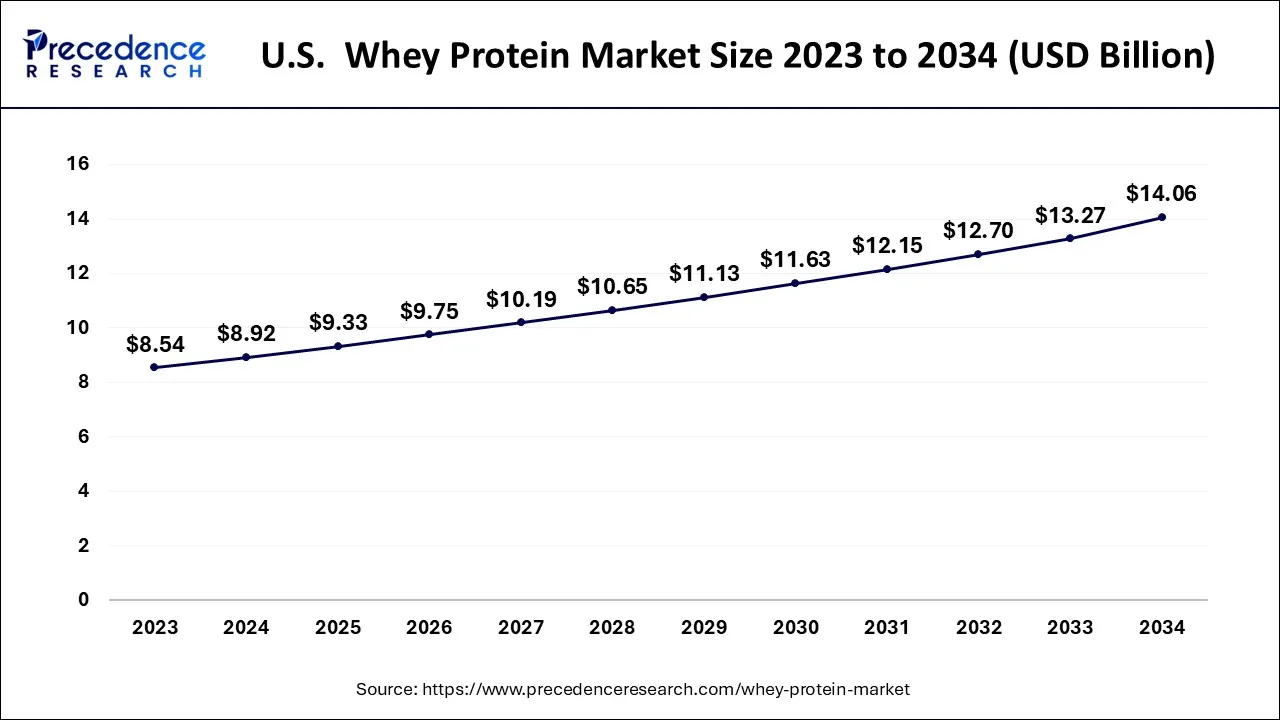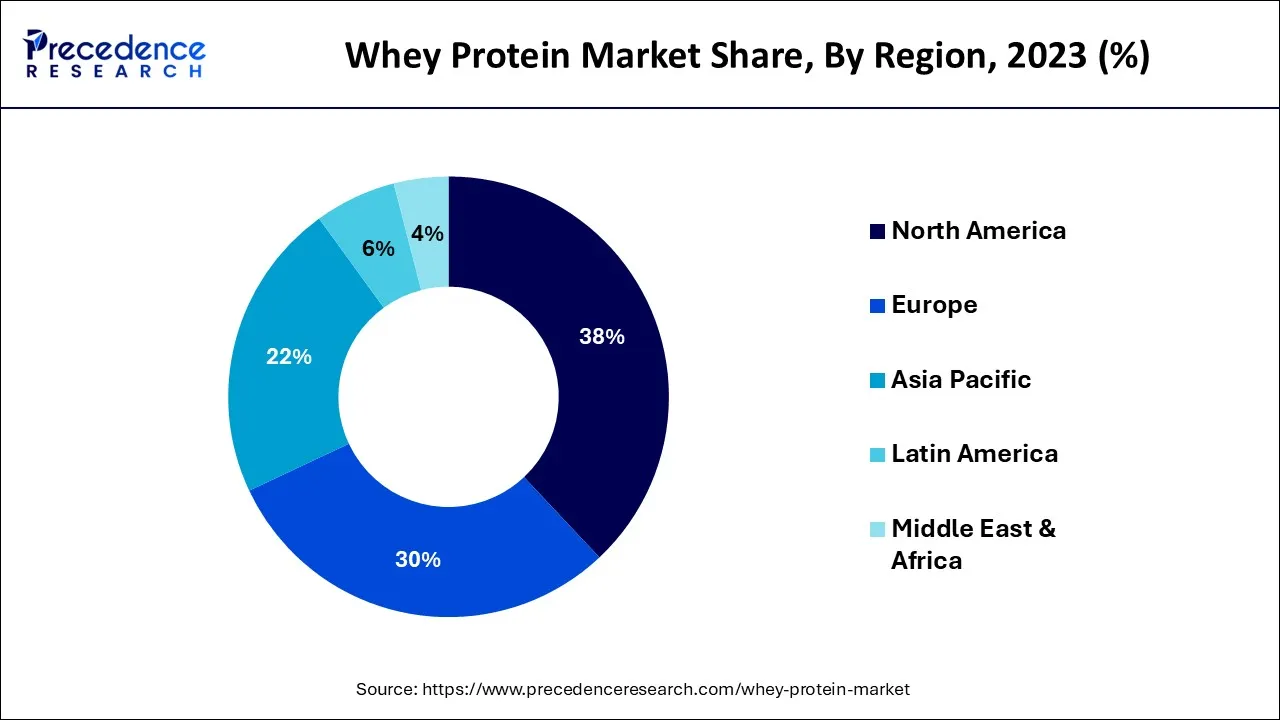Whey Protein Market Size and Forecast 2025 to 2034
The global whey protein market was valued at USD 9.78 billion in 2024, and is projected to hit around USD 10.65 billion by 2025, and is anticipated to reach around USD 22.95 billion by 2034, expanding at a CAGR of 8.90% over the forecast period from 2025 to 2034.

Whey Protein Market Key Takeaways
- In terms of revenue, the market is valued at $10.65 billion in 2025.
- It is projected to reach $22.95 billion by 2034.
- The market is expected to grow at a CAGR of 8.90% from 2025 to 2034.
- Based on geography, The North America region generated more than 38% of the revenue share in 2024.
- Based on type, the concentrate segment will generate major revenue from 2025 to 2034.
- Based on application, the sports nutrition segment held the dominating position in 2024.
- Based on distribution channel, the supermarkets/hypermarkets segment is expected to have a leading position from 2025 to 2034.
- Based on end users, the athletes segment had a significant amount of revenue has been generated in 2025.
U.S. Whey Protein Market Size and Growth 2025 to 2034
The U.S. whey protein market size accounted for USD 8.92 billion in 2024 and is projected to be worth around USD 14.06 billion by 2034, poised to grow at a CAGR of 4.66% from 2025 to 2034.

The global industry is led by the North American region has a share of 38% in 2024. Increasing disposable income is a leading cause for the sales of the product. A healthy lifestyle is promoted by various platforms, and this has also played a significant role in the growth of the market. The use of this product as a supplement and as functional food has gained popularity in the North American region.
The United States is the major contributor to the whey protein market, owing to the rising consumer demand for nutritional ingredients, increasing use of whey proteins in infant food formulation, growing health awareness, and the adoption of fitness regimes. Moreover, the widespread presence of media that promotes healthy lifestyles to live a long life. The urban centres such as New York, California, and Texas, with the surge in health and fitness lifestyles, create demand hubs for whey protein.
According to the United States Department of Agriculture Foreign Agricultural Service, the United States remains the largest global supplier of high-protein whey, accounting for approximately 47% of the global export market volume through the first 10 months of 2024, up from 44% in 2023. These factors are contributing to the growth of the whey protein market in the region during the forecast period.

Significant growth is registered in the European nations as this product is seen as a preventive healthcare product. Growing demand for protein supplements will increase the sales of the product. This product is a naturally derived product that has a greater demand in the market. As the fitness centers in the Asia Pacific region are increasing gradually, the demand for this product is also expected to grow. The availability of raw materials in the nations like China and India is more, due to which the sales are expected to increase.
Market Overview
Whey protein is a by product that is obtained from the manufacturing process of cottage cheese and cheese casein. Manufacturers of these products are engaged in making better use of whey as the waste management cost or the cost of treatment is high and there are stringent regulatory policies on the environment. Such policies have been adopted by the government of various nations. One of the techniques that makes use of this by product generates it into a dry powder. The introduction of the nanofiltration process and ultrafiltration process led to the use of these latest technologies in producing larger quantities of whey.
Whey protein constitutes good amounts of calcium, potassium, phosphorus, magnesium, and sodium. Another major constituent of whey protein is lactose which plays a significant role in mineral absorption. β lactoglobulin, α lactalbumin, immunoglobin, and glycomacropeptide are all the constituents of whey protein. The incredible nutrient content of whey proteins plays a significant role in providing great nutrition to humans due to which this has become a popular choice in various nations. These nutrients are extremely beneficial for people suffering from cardiovascular problems. This product provides a therapeutic advantage and a nutritional advantage to its consumers.
Whey Protein Market Growth Factors
- Use of whey proteins in infant food formulation.
- Increased use of this product in the food industry.
- Various constituents of whey protein make it extremely popular among the young population due to the benefits offered.
- This product is easily absorbed in the body, and it provides a wide range of amino profiles due to which the market is expected to grow well in the coming years.
Consumption of whey protein increases muscle development which will appeal to gym enthusiasts and athletes. Increasing awareness regarding the benefits associated with the consumption of whey protein will also help in generating good revenue in the coming years. Increased use of whey protein as a protein supplement and its usage in food formulations is also expected to grow in the coming years. Whey protein is a low-calorie product, and it is attributed to an increase in sales. An active lifestyle and a healthy diet are the two main factors driving the market of whey protein. This market has immense potential as it serves the functions of muscle repair, weight loss, satiety, and energy balance.
Increasing awareness regarding the benefits of consuming natural ingredients has also accelerated the sales of whey protein. Whey protein is seen as a premium product, and this is expected to facilitate the growth of the product. Cosmetic products and personal care products make use of whey protein, and it is seen as a premium product. Brand awareness and growth in disposable income will strengthen the product market in the long run.
Market Scope
| Report Coverage | Details |
| Market Size by 2034 | USD 19.26 Billion |
| Market Size in 2025 | USD 10.65 Billion |
| Market Size in 2024 | USD 8.94 Billion |
| Growth Rate from 2025 to 2034 | CAGR of 8.90% |
| Largest Market | North America |
| Base Year | 2024 |
| Forecast Period | 2025 to 2034 |
| Segments Covered | Type, Application, Distribution Channel, End Users and Region |
| Regions Covered | North America, Europe, Asia-Pacific, Latin America and Middle East & Africa |
Market Dynamics
Drivers
Growing demand for protein-rich foods
Consumers across the globe are aware of the products available in the market that serve their personal needs, due to which the use of whey protein has grown significantly in recent times. Consumption of a wholesome diet regularly is next to impossible for most of the population across the globe as the lifestyle of the population is extremely busy and this has led to increased consumption of whey protein. Protein ingredients are used in packaged food and fortified food products, and it helps in meeting the daily nutrition requirement of an individual due to which the demand for protein-rich foods is expected to grow.
Growing popularity among gym enthusiasts and athletes
Essential organic substances, minerals, fats, vitamins, and proteins are extremely important for fitness enthusiasts. Bodybuilders and athletes consume supplementary products to improve their overall health, promote muscle gain and enhance stamina. Sportspersons and athletes consume such protein powders to build muscles. As the handling and transportation of this product are easy, the market is expected to grow well.
Key Market Restraints
Whey protein is expensive
The premium products available in the market and the cost of formula food for babies and supplementary food products are expensive in nature and this will restrain the market growth during the forecast period.
Key Market Challenges
The growing popularity of plant-based products and vegan diet
After the outbreak of the COVID-19 pandemic, the demand for plant-based products has grown significantly and increasing awareness regarding health has led to increased consumption of a vegan diet. Consumers leading an active lifestyle have also adopted healthy diets. Innovations in the food sector have led to the growth of specific function diets which help with muscle repair, weight loss, and energy balance. Animal protein is being substituted with other products.
Clean labels are gaining popularity in the food industry as well as in the cosmetics industry due to which the market growth of whey protein will be hampered. Plant-based products and vegan products cause minimal harm to the environment. In European countries, the popularity of vegan food has grown drastically. Protein requirements of various classes of people are met by plant-based products and vegan products, this has led to the elimination of whey proteins.
Key Market Opportunities
Growing concern about health and government initiatives
Growing concern about health after the pandemic in various nations has led to an increase in the number of initiatives taken by the government which is anticipated to provide opportunities for the growth of the whey market. Fitness centers and wellness centers across the globe have increased in numbers, creating more demand for this product. Growing concerns about boosting immunity during the pandemic had led to increased consumption of whey proteins and the results obtained by the consumers have increased the preference for such products.
Type Insights
The concentrate segment will generate maximum revenue in the coming years. These concentrates are soluble and provide minerals lactose and lipids. These concentrates have applications in dairy desserts, beverages, and yogurts due to the flavor of the product. This is a low-cost substitute used in the food industry. Protein-enriched foods and infant nutrition feed make use of the concentrates. It also finds application in the nutritional industry and meat industries. The isolated segment is also expected to generate significant revenue in the coming years. It is a low-fat high protein diet that is gaining popularity as a regular food item.
WPH Segment is also expected to garner a good amount of revenue due to the benefits offered by the product. Antihypertensive, antioxidant, and antimicrobial properties will lead to the growth of this segment. This product finds application in sports nutrition, infant nutrition, and Clinical nutrition. The regulatory policy of the Food and Drug Administration has played a significant role in driving the market for WPH, as it is being used widely in the food industry.
Application Insights
The sports nutrition segment held the dominating position in the past. The beverage industry and the food industry make extensive use of whey proteins. There are many health benefits associated with the consumption of energy drinks, confectionery products, and bakery products that make use of whey protein. The use of this product in the food and beverages industry helps in enhancing the flavor of the food product. It is used as a stabilizing and emulsifying agent. All of these factors will lead to the growth of the segment in the coming years.
Weight management and sports nutrition are playing a significant role in the growth of the segment. Whey protein is used in the manufacturing of beverages, powders, and bars. Growing recommendations for consuming these protein powders from fitness centers will also increase the sales of the product. The cosmetic industry is also making use of this product in manufacturing procedures. Hair conditioners, hair shampoos, colors, hair dyes, face creams, and eye care products are manufactured with the use of whey protein.
Distribution Channel Insights
The hypermarkets and supermarkets segment is expected to have a leading position. A wide range of products available in the supermarkets at discounted rates will help in the growth of the market. Specialty stores have also generated a significant amount of revenue in the past due to the consistent purchases of the product by regular consumers. The growing popularity of online stores after the outbreak of the COVID-19 pandemic has played a significant role in increasing the sales of these products.
End User Insights
The athlete's segment had a significant amount of revenue has been generated through this segment in 2022. Lifestyle users and bodybuilders also have a significant share of the total revenue generated through the sales of the product. Growing awareness about the health benefits associated with the consumption of whey proteins will increase the consumption of the product in the long run.
Whey Protein Market Companies
- Glanbia plc. (Ireland)
- Now Health Group, Inc. (U.S.)
- Nutiva Inc (U.S.)
- The Simply Good Food Co (U.S.)
- Iovate Health Sciences International Inc. (Canada)
- MusclePharm Corporation (U.S.)
- Kerry Group Plc (Ireland)
- CytoSport, Inc. (U.S.)
- The Nature's Bounty Co. (U.S.)
- Reliance Vitamin Company, Inc. (U.S.)
- Herbalife Nutrition, Inc. (U.S.)
- Danone SA (France)
- General Nutrition Centers (GNC) Holdings, Inc. (U.S.)
- Orgain Inc. (U.S.)
- True Nutrition (U.S.)
Recent Development
- In May 2024, Liberation Labs partnered with Vivici to produce animal-free at its biomanufacturing facility in Richmond, Indiana. The initial phase of the facility with 600,000-L of fermentation capacity should be complete by the end of the year, says Liberation Labs, which is conducting a feasibility study funded by the Department of Defense to expand the site to a 4-million-liter facility.
- In March 2025, GNC, a global leader in nutritional supplements, through Guardian Healthcare Pvt. Ltd, GNC's master franchise in India, launched GNC Pro Performance 100% Whey + Nitro Surge, a groundbreaking protein supplement designed to enhance performance and support cardiovascular health. This product features a unique cardio-protective formulation, combining performance-boosting ingredients with heart health benefits.
- In March 2025, Arla Foods Ingredients unveiled its plan to increase its US production capacity through a new contract manufacturing agreement with Valley Queen, a leading dairy processor based in South Dakota. The collaboration aims to meet the rising demand for high-protein dairy products in North America while strengthening Arla's position in the whey protein market.
- In 2021, a five-year strategy was adopted by Arla Foods to manufacture sustainable dairy products for the growth of the business. One of the strategies aims at making more investments in the business of whey ingredients.
Segments Covered in the Report
By Type
- Isolates
- Concentrates
- Demineralized
- Hydrolysate
By Application
- Nutritional
- Personal Care
- Food
- Feed
- Infant Formula
- Sports and Performance Nutrition
- Functional/Fortified Food
By Distribution channel
- Supermarkets/Hypermarkets
- Convenience Stores
- Specialty Stores
- Online Stores
- Other Distribution Channels
By End Users
- Athletes
- Bodybuilders
- Lifestyle Users
ByRegion
- North America
- Europe
- Asia-Pacific
- Latin America
- The Middle East and Africa
For inquiries regarding discounts, bulk purchases, or customization requests, please contact us at sales@precedenceresearch.com
Frequently Asked Questions
Ask For Sample
No cookie-cutter, only authentic analysis – take the 1st step to become a Precedence Research client
 sales@precedenceresearch.com
sales@precedenceresearch.com
 +1 804-441-9344
+1 804-441-9344